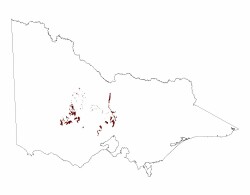2.1.1 Ridges, escarpments, mountains on non-granitic Palaeozoic rocks (Ararat, Colbinabbin, Pyrenees, Tarrangower, Big Hill, Mt Macedon)
2. Western Uplands (WU)
2.1 Dissected Uplands
| In general, the landscapes of the Palaeozoic sedimentary rocks are characterised by undulating low hills dissected by a dendritic drainage pattern that forms the upper catchments of the Moorabool River, Leigh River and Woady Yaloak River drainage systems. The primary drainage trends are parallel to the strike of the bedrock strata and the secondary drainage is controlled by geological boundaries (i.e. lithological boundaries) and rock structures (i.e. faults, joints). The sedimentary rocks generally form the drainage divide along the northern eastern boundary of the Corangamite CMA region and rise to a high point of 740 m north of Barkstead. The larger landscape elements are remnants of the deeply weathered Palaeogene palaeosurface. At Ballarat, the weathering extends up to 100 m below the surface, with secondary mineral development (e.g. kaolin clay) producing the typical bleached and pallid regolith profiles in the Palaeozoic rocks. The oxidation of iron-rich groundwaters has precipitated iron cement into joints and the upper regolith materials. In some areas, remnants of Palaeogene weathering in the form of siliceous and ferruginous duricrusts are preserved by the inversion of relief. The Palaeozoic sedimentary rocks generally have texture contrast soils, often with well developed, bleached subsurface (A2) horizons. However, the geologically recent landscape development and the significant land use change of the past 150 years have stripped the profile in many places. Intensive shallow gold mining has disturbed many hundreds of hectares such that the original soil profile no longer exists and new soil profiles have started to form. |  |
The ridges, escarpments and mountains are located within the upper catchments of the Wimmera River, Mount William Creek and Mount Cole Creek drainage networks. Occurring throughout the Midlands (including North Central and Glenelg Hopkins CMA regions), these landscape features often adjoin the hills, rises and plains of similar broad geological lithologies. The Ararat Hills with the Pyrenees Ranges are examples of these Palaeozoic rock landforms. The topography of the Pyrenees Ranges becomes more subdued in the north-west where it merges in with the Avon plains to the south-west and south-east. Major ridges are orientated along strike (north-west) with rectangular stream channel patterns that are generally orientated in a north-east orientation that often reflect jointing and faulting. Hillslopes are generally greater than 20% with the very steep deeply dissected hillslopes (>56%) of the Pyrenees Ranges located near Glenpatrick. Highest peaks within the Wimmera CMA region include Blue Mount (763 m). The Ararat Hills occur as four parallel high ridges extending from near Great Western to Mount Chalambar) and are significant landscape elements with highest peaks including Mount Ararat (618 m) and One Tree Hill (579 m). Stream channel patterns of these ridges reflect the narrow linear orientation of the strike ridges with drainage unidirectional until drainage converges on lower slopes of neighbouring rises and plains. Hillslopes are more subdued that the slightly steeper terrain of the Pyrenees Ranges with very steep slopes (>56%) confined to upper slopes surrounding the summit of Mount Ararat. The bedrock ridges, fault scarps and monoclines (Joyce 1992) of sedimentary rocks largely consist of sandstones, shales and mudstones that have been intensively folded and faulted in Post-Ordovician times. Later regional and contact metamorphism events saw alteration into metasediments including slates, hornfels, and schists with significant loads of quartz (some gold bearing) as reefs and veins (Sibley 1967). These landscape elements through differential erosion are remnants of a deeply weathered Palaeogene palaeosurface with rock outcrops fewer and smaller in the north-west of the upper catchment reaches. Depth of regolith is irregular across these landscapes, however are more consistent than sedimentary landscapes with southerly aspects further east. Pallid kaolinitic profiles are often up to 15 m thick with residual ferricrete and reef quartz (Joyce 1992; Taylor & Joyce 1996; Joyce 1998; Carey & Hughes 2002). In some areas, remnants of Palaeogene weathering in the form of siliceous and ferruginous duricrusts are preserved by the inversion of relief and development of structurally bound drainage networks. Soils that have developed on these landforms are red texture contrast soils (Chromosols) that may be sodic (Sodosols) especially where rainfall is lower and in lower topographic positions. Slightly acidic, they often tend to neutral pH with depth. Structured surfaces overlie sporadically bleached horizons with variable amounts of coarse weathered bedrock fragments and quartz. Lower slopes have deeper profiles including red-mottled brown and yellow variants. Heathy Dry Forest and Grassy Dry Forest are found mostly in exposed areas of the Pyrenees Ranges and Ararat Hills while Herb-rich Foothill Forest, Grassy Dry Forest and Valley Grassy Forest are more closely associated with sheltered steep to very steep hillslopes and drainage lines. Other vegetation communities recorded include Rocky Outcrop Shrubland on ridge crests, Hillcrest Herb-rich Woodland, Box Ironbark Forest, Alluvial Terraces Herb-rich Woodland and Grassy Woodland on lower slopes and drainage lines. As high elevation areas within the Wimmera CMA region, hillslopes and crests are considered high rainfall recharge areas with little to no saline discharge within landscapes. Landslides have been observed as slip scars in the Ararat Hills (on the south-eastern slopes of Mount Ararat) where land was cleared as part of historic pastoral runs. The fractured nature of these folded and fractured rocks permits large volumes of groundwater to be stored, and removed from the system usually as break of slope events within these local systems. | |


